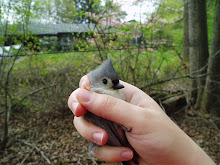It turns out that Anax junius likes to hang out more towards the middle of the pond. Lacking waders, I practiced catching anything I could. (Things like coordination don't always come easily to me.) I also don't have a great camera for macro stuff. One of these days I'll get a better one, but in the meantime I still got some decent pics!
OK, less talking, more dragons!
First up is Pachydiplax longipennis, also known as the blue dasher. That is the standard way of holding dragonflies after you catch them, by the way. This guy was a lot more blue than the picture looks, but it's sort of hard to see.
If this is what I think it is (but I don't have a great field guide) then it is the aptly-named brown-spotted yellow-wing, Celithemis eponina. Unfortunately, standard dragonfly holding procedure obscures a lot of the beautiful wing patterning, so check out Wikipedia for more. The wings on these guys are lovely! If I've ID'd it correctly, it's also known as the Halloween pennant. Even if I don't have the species quite right, I feel pretty good saying that it's at least in Celithemis.
I don't have a good handle on this one. I suspect it might be Libellula vibrans, the great blue skimmer, but I'm really not sure. There's a picture of one on this page about the genus Libellula, but ... I don't know. I'll have to send this post to Mike and ask him.
(Editor's note: See next post for correction.)
I'm pretty sure this one is a white-tail, Plathemis lydia. Why? The tail is white. (Actually, there may be several species of white-tails, but there is only one in my field guide. Hopefully the correct one. )
And, finally, the pièce de résistance, the trophy at the end of several hot hours standing in the sun by a mucky pond with a net, the big kahuna we were hunting all day:

Mike holding our first and only Anax junius of the second day out.

Waiting for the glue on the transmitter to dry.
After being manhandled for several minutes, they need to shiver their flight muscles to get warm enough to take off. Payload firmly attached, he was airborne a few seconds after this pictures.
We tracked him for about an hour with a pretty strong signal, first up in the woods and the back to the pond area where Mike had originally caught him. And then, suddenly, the signal vanished. We waited awhile, but he did not return. Perhaps he decided that this pond was too dangerous.
PS: You might be interested to know, for scale, that my left thumb nail, which features prominently in all but the pictures of Anax, is almost exactly one-half inch wide. You might also be interested to know that "longipennis" means "long-winged", despite what I know you were thinking. Apparently penna means "feather" in Latin and is related to the word "pennant". Penna is also the root of the word "pinion", meaning both the outer part of a bird's wing and the removal thereof to permanently prevent flight. Aren't you glad you asked? Entomology and etymology, all in one convenient location.








No comments:
Post a Comment